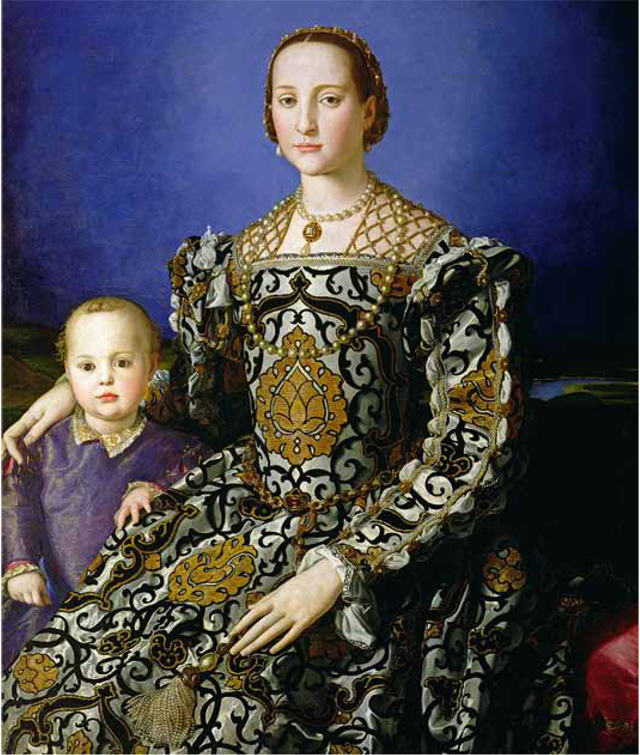My Favourite Painting: Olga Polizzi
Olga Polizzi chooses her favourite painting for Country Life.


Eleonora di Toledo with her son Giovanni, 1545, by Agnolo di Cosimo di Mariano called Bronzino (1503–72), 46in by 382⁄5in, Uffizi, Florence. Bridgeman Images.
Olga Polizzi says: 'I am always drawn to portraits of mother and child. This one is particularly beautiful. The pale skin, the long, slim-fingered hands sitting in the folds of the stunning dress, silk and velvet, embroidered appliqué and the very large natural pearls worthy of a very grande dame. Many people think this is a cold, arrogant portrait of a not very maternal woman, but I do not agree. Eleonora was very clever and competent, a very good wife and mother of 11 children. Here, she looks so young and serene. Mother and young son look alike, with their high foreheads and heavy lidded eyes. To me, this portrait is extremely touching.'
Olga Polizzi is a hotelier and interior designer.
John McEwen comments: 'The late Sir Michael Levey described Bronzino as the last great painter of the Florentine Renaissance. Bronzino (his adopted name described the colour of his hair) was the son of a Florentine butcher and favourite pupil of the Mannerist pioneer Jacopo Pontormo (1494–1557). He was noted for kindness. Latterly, he lived with an armourer’s family and looked after them when the husband died. Pontormo’s journal also tells of Bronzino’s lifelong concern for him.
Bronzino, a poet-painter, wrote 19 sonnets lamenting Pontormo’s death and completed some of his unfinished frescoes. It was with Pontormo that he first worked for the Medici and, in due course, he became Court Painter to Cosimo I de’ Medici, following the latter’s marriage to Eleonora di Toledo (1522–62). Eleonora was a daughter of the Marquis of Villafranca, Spanish viceroy of Naples. She introduced the royal blood the Medici had lacked, thus legitimising their sovereign status. Eleonora had 11 children and is shown with her younger son, Giovanni, destined by Medici tradition to be Pope. In the event, he only became a cardinal.
One copy of the painting is in the Wallace Collection. Eleonora was a successful consort in her own right. She overcame her alien nationality to earn the love of her people, founded many churches and served as regent in Cosimo’s absence. Her large family consolidated the power of the Medici for a further century, a fecundity symbolised by the stylised gold-thread pomegranates on her brocade dress. She and two of her children were victims of a malaria epidemic.'
This article was first published in Country Life, March 5, 2014
Sign up for the Country Life Newsletter
Exquisite houses, the beauty of Nature, and how to get the most from your life, straight to your inbox.
Country Life is unlike any other magazine: the only glossy weekly on the newsstand and the only magazine that has been guest-edited by HRH The King not once, but twice. It is a celebration of modern rural life and all its diverse joys and pleasures — that was first published in Queen Victoria's Diamond Jubilee year. Our eclectic mixture of witty and informative content — from the most up-to-date property news and commentary and a coveted glimpse inside some of the UK's best houses and gardens, to gardening, the arts and interior design, written by experts in their field — still cannot be found in print or online, anywhere else.
-
 Six rural properties with space, charm and endless views, as seen in Country Life
Six rural properties with space, charm and endless views, as seen in Country LifeWe take a look at some of the best houses to come to the market via Country Life in the past week.
By Toby Keel
-
 Exploring the countryside is essential for our wellbeing, but Right to Roam is going backwards
Exploring the countryside is essential for our wellbeing, but Right to Roam is going backwardsCampaigners in England often point to Scotland as an example of how brilliantly Right to Roam works, but it's not all it's cracked up to be, says Patrick Galbraith.
By Patrick Galbraith
-
 My favourite painting: Allan Mallinson
My favourite painting: Allan MallinsonMilitary historian Allan Mallinson picks an image of 'faith, generosity and ultimate sacrifice'.
By Charlotte Mullins
-
 My Favourite Painting: Piet Oudolf
My Favourite Painting: Piet Oudolf'One cannot sense whether he is far out on the ocean or closer to shore, or what he may be watching or feeling in that moment as he stares towards the beach.’
By Country Life
-
 My Favourite Painting: Mary Plazas
My Favourite Painting: Mary Plazas'There is compassion, awe, humility, a knowing yet a questioning in the glistening eyes. It moves me, it inspires me beyond the need to know.’
By Country Life
-
 My favourite painting: Robert Kime
My favourite painting: Robert KimeRobert Kime shares his fondness for New Year Snow by Ravilious
By Country Life
-
 My Favourite Painting: Anna Pavord
My Favourite Painting: Anna PavordAnna Pavord chooses a picture which reminds her of where she grew up
By Country Life
-
 My favourite painting: The Duchess of Wellington
My favourite painting: The Duchess of WellingtonThe Duchess of Wellington chooses her favourite painting for Country Life.
By Country Life
-
 My favourite painting: Maureen Lipman
My favourite painting: Maureen LipmanMaureen Lipman chooses her favourite painting for Country Life.
By Country Life
-
 My favourite painting: Jacqueline Wilson
My favourite painting: Jacqueline Wilson'I looked at this painting and decided to write about a Victorian circus girl one day'
By Country Life